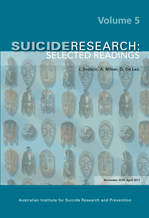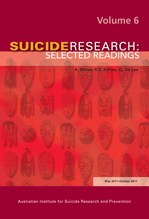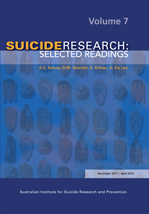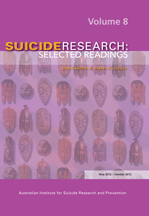Suicide Research: Selected Readings Volume 9
Edited by E. Barker, A-M. Snider, S. McPhedran
Australian Institute for Suicide Research and PreventionForeword
This
volume contains quotations from internationally peer-reviewed suicide research
published during the semester November 2012 – April 2013; it is the ninth of a
series produced biannually by our Institute with the aim of assisting the
Commonwealth Department of Health and Ageing in being constantly updated on new
evidences from the scientific community. Compared to previous volumes, an
increased number of examined materials have to be referred. In fact, during the
current semester, the number of articles scrutinised has been the highest yet,
with a progression that testifies a remarkably growing interest from scholars
for the field of suicide research (718 articles for the first, 757 for the second, 892 for the third, 1,121
for the fourth, 1,276 for the fifth, 1,472 for the sixth, 1,515 for the seventh,
1,743 for the eighth and 1, 751 in the present volume).
As
usual, the initial section of the volume collects a number of publications that
could have particular relevance for the Australian people in terms of potential
applicability. These publications are accompanied by a short comment from us,
and an explanation of the motives that justify why we have considered of
interest the implementation of studies’ findings in the Australian context. An
introductory part provides the rationale and the methodology followed in the
identification of papers.
The
central part of the volume represents a selection of research articles of
particular significance; their abstracts are reported in extenso, underlining our invitation at reading those papers in
full text: they represent a remarkable advancement of suicide research
knowledge.
The
last section reports all items retrievable from major electronic databases. We
have catalogued them on the basis of their prevailing reference to fatal and
non-fatal suicidal behaviours, with various sub-headings (e.g. epidemiology,
risk factors, etc). The deriving
list guarantees a level of completeness superior to any individual system; it
can constitute a useful tool for all those interested in a quick update of what
most recently published on the topic.
Our
intent was to make suicide research more approachable to non-specialists, and
in the meantime provide an opportunity for a vademecum of quotations credible also at the professional level. A
compilation such as the one that we provide here is not easily obtainable from
usual sources and can save a considerable amount of time to readers. We believe
that our effort in this direction may be an appropriate interpretation of one
of the technical support roles to the Government that the new status of
National Centre of Excellence in Suicide Prevention – which has deeply honoured
our commitment – entails for us.
The
significant growth of our centre, the Australian Institute for Suicide Research
and Prevention, and its influential function, both nationally and
internationally, in the fight against suicide, could not happen without the
constant support of Queensland Health and Griffith University. We hope that our
passionate dedication to the cause of suicide prevention may compensate their
continuing trust in our work.
Diego De Leo, DSc
OTHER VOLUMES AVAILABLE IN THIS SERIES:




